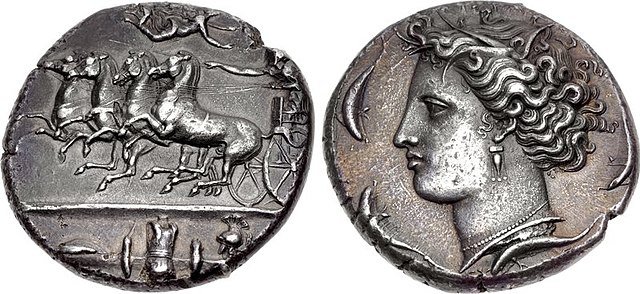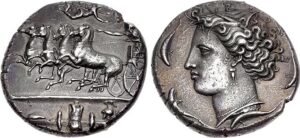The by Kimon
A masterpiece of ancient Greek coinage of Syracuse decadrachm is one of the most preferable coins in numismatic field.
Why This Syracuse decadrachm Coin Still Stuns Collectors
Well when you see the ancient coins now and think you recognize that some coins are just currency, but some are piece of art.
And one of them is the Syracuse decadrachm by Kimon — a coin so masterful, so perfectly balanced between myth, politics, and aesthetics, that it doesn’t just belong in a collection… it belongs on a pedestal.
Minted in Sicily around 405–400 BC, this isn’t just one of the finest ancient Greek coins ever struck — it’s a coin that whispers stories from the very heart of classical Greece’s golden age.
What You’re Looking At
-
Material: Silver (AR)
-
Diameter: ~32 mm
-
Weight: ~43.16 grams
-
Engraver: Kimon, one of the most revered artists in Greek numismatics
-
Location: Syracuse, Sicily
Now let’s explore what makes this particular decadrachm such a legend — and why collectors still chase it after 2,400 years.
🐎 Obverse: The Power of Motion and Myth
At first glance, the quadriga (four-horse chariot) almost leaps off the coin. It’s full of movement — the horses charge left, driven by a female charioteer leaning into the reins, holding a kentron in one hand.
Above her? Nike — the goddess of victory — flies in mid-air, ready to crown her with a laurel wreath.
Beneath it all, nestled just under the exergual line, you’ll find:
-
A shield
-
A crested Corinthian helmet
-
A cuirass placed between greaves
These aren’t random military props — they represent “AΘΛA”, or athletic/military prizes. They hint at glory in both war and sport — likely a nod to Syracuse’s military victories and its Olympic ambitions.
💡 Why It Matters: This isn’t just a racing scene. It’s layered propaganda — power, triumph, divinity — all pressed into a coin barely larger than a poker chip.
🧜♀️ Reverse: The Calm Beneath the Sea – Arethusa
Turn the coin over and meet Arethusa, the revered sea nymph of Syracuse. Kimon doesn’t just engrave her. He sculpts her.
-
She’s shown in left profile, serene and composed
-
Her hair is netted, with a ribbon tied around her head — marked with the tiny “ΚΙ”
-
She wears a lotus-blossom earring and an elegant beaded necklace
Around her, four dolphins swim — symbols of her connection to the sea. One even touches the base of her neck — a small detail, but one that gives the composition real depth.
💡 Why It Stands Out: This isn’t idealized beauty. It’s intimate artistry — you can almost feel her presence. Many consider it the finest engraved portrait on any Greek coin.
Kimon’s Signature: Three Subtle Autographs
Most ancient engravers left no trace. Not Kimon. He signed this masterpiece three times:
-
“ΚΙ” on Arethusa’s headband
-
“KIMΩN” beneath her neck — engraved on the dolphin
-
Tiny signature letters hidden on the obverse exergual line
These aren’t vanity marks. They’re pride. Proof that Kimon knew what he was creating — and wanted future generations to know too.
⏳ Historical Background: Born from Victory
To really appreciate this coin, you need to understand why it was minted.
The decadrachm was born from one of Syracuse’s greatest moments: its victory over Athens during the disastrous Sicilian Expedition (415–413 BC) in the Peloponnesian War.
Athens came to conquer. Syracuse held out — then turned the tide. The Syracusans captured Athenian ships, enslaved thousands of soldiers, and reasserted dominance in the west.
And with the spoils of war — silver, slaves, pride — they minted these coins.
💡 Think of it like this: Athens had the Parthenon. Syracuse had the decadrachm.
🎨 Artistic Brilliance: The Age of Signing Masters
This coin isn’t just about Arethusa or chariots — it’s part of a movement.
The “age of the signing artists” saw engravers step forward as real creators. Kimon, along with Euainetos, pushed the boundaries of what could fit on a coin. Shadows, depth, motion — they made metal breathe.
💡 Collectors often say: “You don’t just see these coins — you feel them.”
🏛️ Provenance: A Coin with a Story
This particular specimen isn’t just rare — it’s storied.
-
Appeared in Florange & Ciani, February 1925
-
Sold through Nomos Sale 10, 2015
-
Featured in NAC 96, America Collection, 2016
-
Found in the Noto (Falconera) Hoard, Sicily, 1908
Provenance like this doesn’t just verify authenticity — it adds soul. This coin has passed through the hands of kings of the collecting world.
💰 Rarity & Market Value
True Syracuse decadrachms — especially signed by Kimon — are among the most sought-after silver coins in existence.
-
Top examples fetch well over six figures at auction
-
The highest-grade specimens often break the $250,000–$500,000 range
-
Most are housed in museums or locked in private collections
💡 Bottom line: If you ever get offered one — authenticated, provenanced, and sharp — it’s not just a purchase. It’s a legacy acquisition.
Final Word: The Pinnacle of Greek Numismatics
The Syracuse decadrachm isn’t just a coin. It’s a monument — struck not in marble, but in silver.
It represents:
-
A city’s military pride
-
An engraver’s unmatched talent
-
A culture’s peak aesthetic
Well, whether you’re a numismatist, a historian, or just someone who appreciates artistic genius, this is the kind of piece that makes you pause. Stare. And appreciate the fact that 2,400 years ago, someone with a hammer, a die, and a dream made something eternal.

